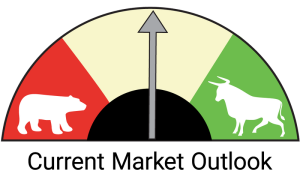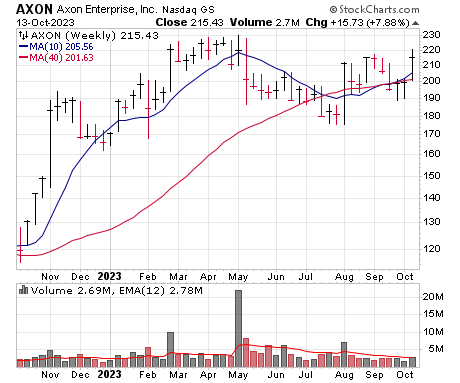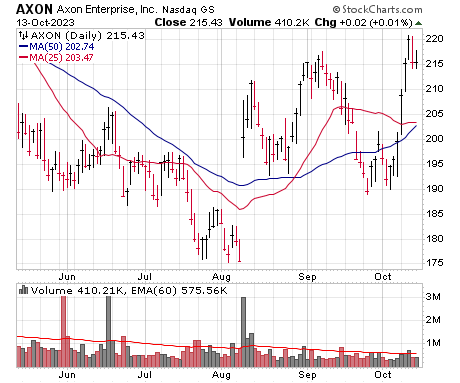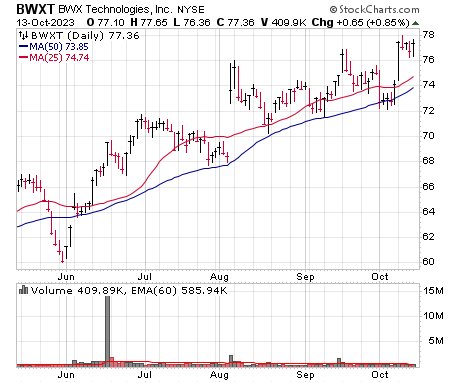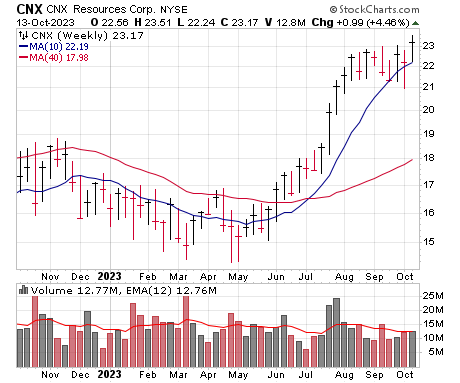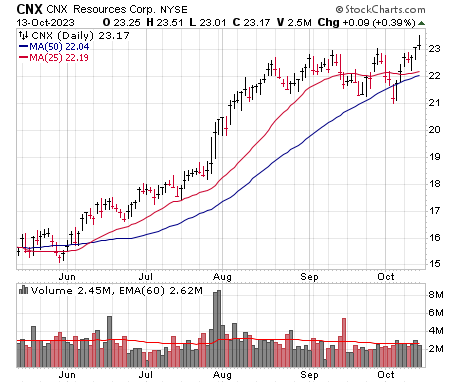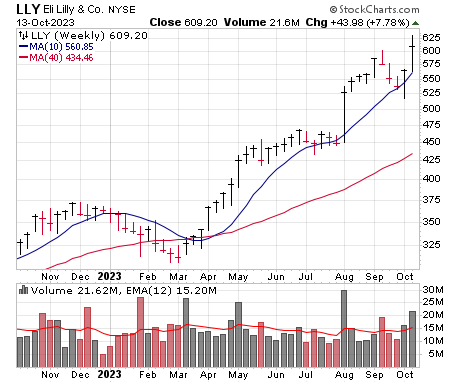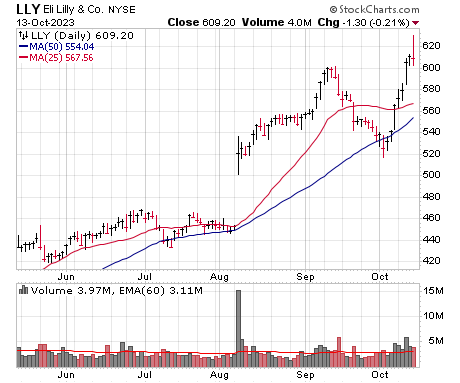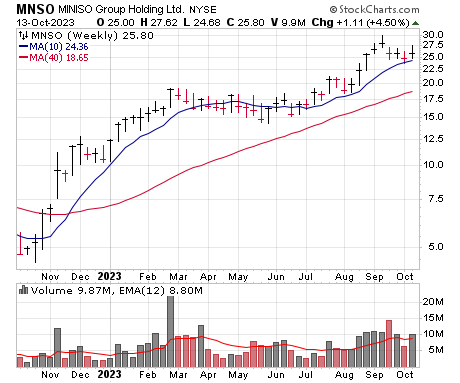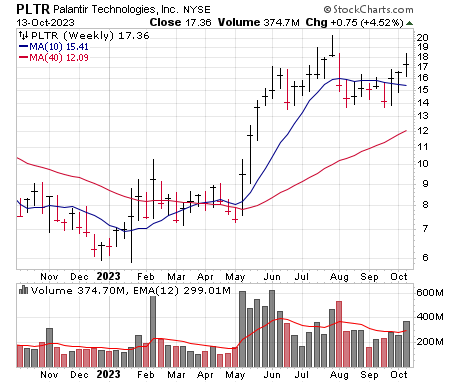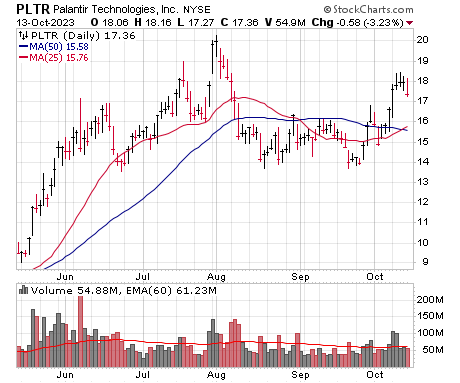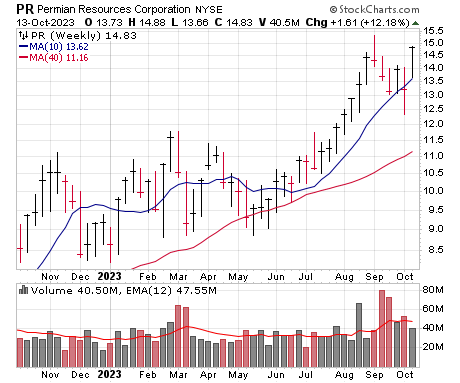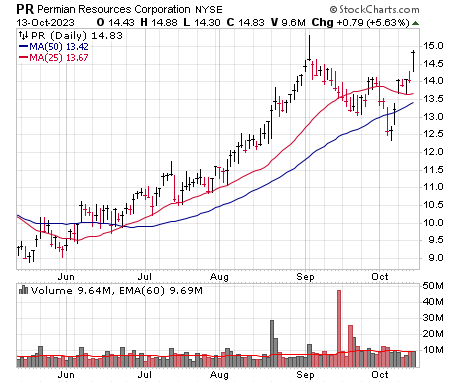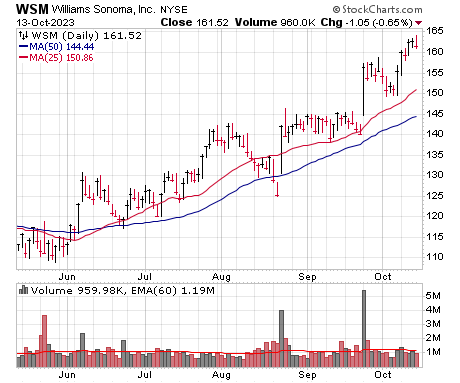Here Comes Earnings Season
The story remains mostly the same in the market as it has for the past few weeks: The intermediate-term trend for nearly all major indexes and the vast majority of individual stocks and sectors is pointed down, with very few stocks hitting new highs and those that do often being quickly met with selling pressures. That said, there also are a decent number of stocks holding up fairly well—most aren’t ready to break out tomorrow, per se, but with earnings season starting in a major way this week, the potential is there for some leadership to develop if we see some strong upside gaps following reports. We’re all for it happening, and in the meantime, some nibbles on dips and partial profits on strength can work, but overall it’s best to remain cautious as the market attempts to turn the corner; if things really get moving, there will be time to hop onboard some powerful leaders, but more patience is needed right here. Once again, we’ll leave our Market Monitor at a level 5.
This week’s list has a wide array of good-looking names, though for our Top Pick we’re going with a liquid leader that, while not in the first inning of its run, acts like it wants to go higher: Eli Lilly (LLY) has a few big-potential drugs in its pipeline, with one potential indication for weight loss likely to be a mega-blockbuster. Try to buy on dips.
Price |
| Axon Enterprise (AXON) |
| BWX Technologies (BWXT) |
| CNX Resources (CNX) |
| Eli Lilly (LLY) ★ Top Pick ★ |
| HealthEquity (HQY) |
| MINISO Group (MNSO) |
| Onto Innovation (ONTO) |
| Palantir Technologies (PLTR) |
| Permian Resources (PR) |
| Williams-Sonoma (WSM) |
Stock 1
Axon Enterprise (AXON)
Price |
Why the Strength
Ever since Axon Enterprise expanded its business beyond just stun guns (Tasers) and moved toward a subscription-type model, the results have been outstanding—yet the stock has been hectic as sponsorship was iffy. Now, though, more than 1,300 funds own shares (up from 716 nine months ago) and the stock is set up for a nice move if things go right. The story is both simple and powerful, as the company has positioned itself as the leading public safety play: Tasers are still a big part of the business (about 41% of revenue), and there have been some real advancements here, with more probes and a greater range in the latest release, both of which should continue to cut down on unwanted deaths. But the big draws for investors now are the firms various body and in-car cameras, as well as its cloud offerings, including dispatch, response and report software as well as Evidence.com, which allows departments to manage, store and share evidence online. At this point, 90% of revenues are subscription-based (even Tasers are being sold with recurring bundles that include updates and training), which obviously adds reliability to results, and the market is huge both in the U.S. and in other English speaking countries (U.K. and Australia); Axon sees a $50 billion addressable opportunity, with its cloud products still in the very early phases of being adopted. Growth has been solid (six straight quarters of 30%-plus revenue growth) and should be resilient no matter what the economy does, and the sub-metrics point toward growth continuing for a long time—in Q2, Axon’s annualized recurring revenue totaled $559 million, up 52% from a year ago, while total future contracted revenue was north of $5.2 billion (up 57%) and same-customer revenue growth was a very solid 22%. To be fair, EBITDA is expected to rise just 20% this year, but there’s little doubt the top and bottom lines have plenty of upside down the road. It’s a good story.
Technical Analysis
AXON actually moved to new all-time highs in March and held up through April before getting nailed on earnings in early May, leading to a 24% slide into August. A gap up on earnings that month helped the cause, with the stock stabilizing above its lows for a few weeks, and this month AXON has found buying, racing back toward its highs. There’s resistance in this area, so we’ll set our buy range a few points down from here, thinking a near-term dip is more likely than not.
| Market Cap | $16.2B | EPS $ Annual (Dec) | ||
| Forward P/E | 61 | FY 2021 | 2.35 | |
| Current P/E | 65 | FY 2022 | 2.19 | |
| Annual Revenue | $1.37B | FY 2023e | 3.57 | |
| Profit Margin | 22.6% | FY 2024e | 3.85 | |
| Qtrly Rev | Qtrly Rev Growth | Qtrly EPS | Qtrly EPS Growth | |
| ($M) | (vs. yr-ago-qtr) | ($) | (vs. yr-ago-qtr) | |
| Latest qtr | 375 | 31% | 1.11 | 152% |
| One qtr ago | 343 | 34% | 0.88 | 96% |
| Two qtrs ago | 336 | 54% | 0.70 | 52% |
| Three qtrs ago | 312 | 34% | 0.60 | -49% |
Weekly Chart | Daily Chart |
Stock 2
BWX Technologies (BWXT)
Price |
Why the Strength
BWX is a leading public sector supplier of nuclear components and fuel, as well as technical and site services, to assist in the operation of nuclear facilities and environmental restoration. BWX further supplies precision manufactured components, services and heavy water (CANDU) fuel for the commercial nuclear power industry—a major growth driver as nations actively seek to reduce carbon emissions. However, the reason for the stock’s latest strength is BWX’s exposure to the defense industry in light of the military conflagration in the Middle East. Indeed, much of the company’s revenue comes from engineering nuclear reactors for U.S. naval submarines (the U.S. government is its biggest customer); a major Wall Street bank just released a report naming BWX as one of several likely beneficiaries of increased government defense spending in the coming years “as spending mix shifts to the weapons-buying accounts.” The bank cautioned that while the expected ramp in defense spending likely won’t be immediate, BWX and its defense contractor peers can expect margins to begin expanding next year and into 2025 (and possibly beyond) as the industry adds capacity for higher production. On the aerospace front, BWX was picked by a U.S. Defense Department agency to jointly develop a nuclear-powered spacecraft with Lockheed Martin by 2027. (BWX will provide the reactor and make uranium fuel for the spacecraft, as nuclear propulsion is seen as necessary to support a trip to Mars.) The contract win prompted another major Wall Street institution to upgrade the stock (another reason for the strength). In Q2, BWX saw an 11% year-on-year revenue increase, plus earnings of 65 cents a share that beat estimates by 8%. When Q3 results are reported on November 1, analysts expect sales to grow by 10%, with slow but steady growth in the quarters that follow.
Technical Analysis
After experiencing some minor weakness into January, BWXT touched down at the 40-week line and launched a multi-month rally before again pulling back to that trend line in late May. The stock quickly recovered in early June and pushed to higher highs, then gapped up on earnings in August. The last several weeks have seen shares chop around in a narrow range, but last week’s rally to 12-month highs suggests the buyers are still in control. We’re OK grabbing shares here or (preferably) on dips with a tight stop under the 50-day line.
| Market Cap | $7.10B | EPS $ Annual (Dec) | ||
| Forward P/E | 26 | FY 2021 | 3.06 | |
| Current P/E | 26 | FY 2022 | 3.13 | |
| Annual Revenue | $2.33B | FY 2023e | 2.93 | |
| Profit Margin | 9.7% | FY 2024e | 3.09 | |
| Qtrly Rev | Qtrly Rev Growth | Qtrly EPS | Qtrly EPS Growth | |
| ($M) | (vs. yr-ago-qtr) | ($) | (vs. yr-ago-qtr) | |
| Latest qtr | 613 | 11% | 0.65 | -21% |
| One qtr ago | 568 | 7% | 0.70 | 1% |
| Two qtrs ago | 624 | 5% | 0.93 | -2% |
| Three qtrs ago | 524 | 5% | 0.69 | -9% |
Weekly Chart | Daily Chart |
Stock 3
CNX Resources (CNX)
Price |
Why the Strength
After a huge crash into the low- to mid-$2 range, natural gas prices in the U.S. are finally firming up, bolstered by lower production (recently hit multi-year low in the U.S.), with pricing holding above $3 this month. CNX is a premier natural gas development, midstream, and technology company in the energy-rich Appalachia basin, with operations primarily in the Marcellus and Utica Shales in Pennsylvania, Ohio and West Virginia. The company also develops coalbed methane properties in Virginia and runs an extensive methane capture and abatement program in conjunction with other companies. CNX reported its 14th consecutive quarter of free cash flow generation in Q2, with total revenue of $840 million doubling from a year ago and per-share earnings of 30 cents beating estimates by 20%, while free cash flow came in at $135 million (just over 80 cents per share). CNX indicated that drilling and completions are “firing on all cylinders” in the Marcellus and Utica regions, and that the long-term outlook has “never been brighter.” Shortly after the quarter ended, CNX successfully drilled its deepest and longest Utica well, which it said will support the long-term development of “prolific acreage” in this region. Additionally, the firm has plans for four additional Marcellus wells to come online before the year is over. To be fair, with natural gas prices in the basement for much of this year, free cash flow this year will take a big step back ($325 million expected vs. $707 million last year), but those figures should increase now that the commodity is headed back up. Plus, management is using all that cash to help shareholders—first, by paying down some debt (no debt maturities now until 2026) and, more importantly, by buying back a ton of shares (share count down 30% in the past three years!), with another $1 billion buyback authorization recently approved. Obviously, gas prices will be key, but if things go well, CNX could easily crank out $2-plus of free cash flow.
Technical Analysis
CNX topped along with the rest of the natural gas sector in June of last year at 24 and quickly collapsed the next month, beginning a long bottoming effort that saw the stock retesting its lows near 14 in April and May of this year. The rally from there started slowly, but Q2 earnings in late July brought in the buyers, spiking the stock back above 22. CNX has hacked around since then, but a shakeout below the 50-day line quickly found buyers, with shares notching new highs last Friday. If you want in, we’re OK starting small around here or on dips of a few dimes.
| Market Cap | $3.74B | EPS $ Annual (Dec) | ||
| Forward P/E | 14 | FY 2021 | 1.61 | |
| Current P/E | 12 | FY 2022 | 2.81 | |
| Annual Revenue | $3.87B | FY 2023e | 1.66 | |
| Profit Margin | 6.8% | FY 2024e | 1.99 | |
| Qtrly Rev | Qtrly Rev Growth | Qtrly EPS | Qtrly EPS Growth | |
| ($M) | (vs. yr-ago-qtr) | ($) | (vs. yr-ago-qtr) | |
| Latest qtr | 840 | 100% | 0.30 | -51% |
| One qtr ago | 1276 | N/A | 0.55 | -30% |
| Two qtrs ago | 1637 | 27% | 1.64 | 429% |
| Three qtrs ago | 117 | N/A | -0.53 | N/A |
Weekly Chart | Daily Chart |
Stock 4
Eli Lilly (LLY) ★ Top Pick ★
Price |
Why the Strength
Eli Lilly is closing in on approvals for two promising, potentially blockbuster drugs. One is donanemab, a treatment for Alzheimer’s that recently produced positive Phase 3 trial results, demonstrating that the drug significantly slowed cognitive and functional decline in people with early symptomatic Alzheimer’s. Lilly expects the FDA to act on approval by year’s end. The other promising treatment is tirzepatide, marketed as Mounjaro. For the past 18 months it’s been on the market as a treatment for type 2 diabetes. The company is asking for an expansion of its indication to be used for weight management in obese or overweight individuals, and some think if things go well it could be one of the biggest-selling treatments in history. Just this Sunday, Lilly announced tirzepatide (taken via a once-weekly injection) met primary endpoints of efficacy and treatment regimens in Phase 3 trials, where participants taking the drug achieved an average weight loss of more than 26% over 84 weeks compared to just 4% or so for participants on a placebo. (This announcement built on earlier, shorter-term results released in July and includes some lifestyle interventions.) Showing good results in earlier trials is a third promising drug for the treatment of certain forms of leukemia and lymphoma—the treatment, pirtobrutinib, was previously approved by the FDA for a narrower, specific occurrence of lymphomas. Investors see the strong pipeline as offering huge growth prospects for Lilly, which right now is reliant on 70% of its revenue from 10 mostly established drugs (Mounjaro for diabetes being the only recent addition to the group). Business is already doing just fine with Q2 earnings jumping 69% and sales rising 28%, but the focus is on the future, with any new approvals likely to boost the bottom line, and with expectations for Mounjaro through the roof. Analysts see earnings soaring 30% next year and even that could prove conservative. Earnings are due November 2.
Technical Analysis
LLY broke out in April of this year to new all-time highs, part of a stretch of 10 weeks up in a row, which is a clue that big investors were still active. The stock chopped sideways after that, but Q2 earnings gapped the stock higher, and while September offered a tough shakeout, LLY’s big-volume rebound is certainly bullish. To be fair, the stock has had a big run even during the bear market, so it’s not in the first inning of its run, but it certainly looks like it wants to head higher. We’ll set our buy range lower given the recent move and the still-tricky market environment.
| Market Cap | $578B | EPS $ Annual (Dec) | ||
| Forward P/E | 63 | FY 2021 | 7.39 | |
| Current P/E | 78 | FY 2022 | 7.94 | |
| Annual Revenue | $29.5B | FY 2023e | 9.70 | |
| Profit Margin | 22.9% | FY 2024e | 12.57 | |
| Qtrly Rev | Qtrly Rev Growth | Qtrly EPS | Qtrly EPS Growth | |
| ($B) | (vs. yr-ago-qtr) | ($) | (vs. yr-ago-qtr) | |
| Latest qtr | 8.31 | 28% | 2.11 | 69% |
| One qtr ago | 6.96 | -11% | 1.62 | -38% |
| Two qtrs ago | 7.30 | -9% | 2.09 | -4% |
| Three qtrs ago | 6.94 | 2% | 1.98 | 12% |
Weekly Chart | Daily Chart |
Stock 5
HealthEquity (HQY)
Price |
Why the Strength
With more than 15 million members and over eight million health savings accounts (HSAs), HealthEquity is the nation’s largest non-bank HSA trustee. Through its cloud-based platforms, HealthEquity allows customers to lower monthly premiums and long-term payments and serves as a custodian of tax-free HSAs regardless of which financial institution the funds are deposited with. The company also offers a large selection of mutual funds for individuals to invest in within their HSAs, as well as a web-based automated investment advisory services tool. That said, the stock is strong today because the higher-for-longer interest rate scenario that looks more likely, which is leading to big earnings hikes—the stock was upgraded to an “outperform” rating by a major financial institution based on the institution’s observation that HealthEquity’s $14 billion in cash is retained at just a 2.4% effective yield over an average duration of three to four years, which should increase its sales growth and margins as the effective yield lifts “as lower-yielding funds get redeployed over the next few years.” In Q2, HealthEquity’s HSA accounts improved 9% year-on-year, while total assets increased 6% (and 13% sequentially), with total revenue climbing 18% and EPS of 53 cents soaring 61%. The company acknowledged higher rates gave a boost to HSA cash and said invested assets now account for 40% of its HSA assets as more of its members choose enhanced rates for their HSA cash, leading to higher-for-longer custodial yields. Looking ahead, management guided for 2023 revenue of around $985 million, up 14%, and Wall Street sees the bottom line soaring the next few quarters as rates remain elevated for the foreseeable future.
Technical Analysis
HQY peaked just under a year ago near 80 and then proceeded to slide 38% into a May bottom, but it was the June earnings report that changed the trend. The action since then has been solid, with HQY rallying relatively smoothly above its 50-day line during the past few months. Shares have hit some resistance up near their prior high of late, so we’ll set our entry range down a bit from here.
| Market Cap | $6.38B | EPS $ Annual (Jan) | ||
| Forward P/E | 37 | FY 2022 | 1.33 | |
| Current P/E | 42 | FY 2023 | 1.36 | |
| Annual Revenue | $938M | FY 2024e | 2.02 | |
| Profit Margin | 18.7% | FY 2025e | 2.62 | |
| Qtrly Rev | Qtrly Rev Growth | Qtrly EPS | Qtrly EPS Growth | |
| ($M) | (vs. yr-ago-qtr) | ($) | (vs. yr-ago-qtr) | |
| Latest qtr | 244 | 18% | 0.53 | 61% |
| One qtr ago | 244 | 19% | 0.50 | 85% |
| Two qtrs ago | 234 | 15% | 0.37 | 85% |
| Three qtrs ago | 216 | 20% | 0.38 | 9% |
Weekly Chart | Daily Chart |
Stock 6
MINISO Group (MNSO)
Price |
Why the Strength
It’s hard to love Chinese stocks given the always-present regulatory risk, and the fact that the Chinese economy is still struggling also hurts perception. Despite that, we’re seeing more names from that country perk up, and MINISO is a newer one with a simple story. The company is a value-based retailer, offering a bunch of household goods, such as perfume, plushies, pillows, travel accessories, toys, bathroom supplies, drinkware, kitchen tools and much, much more. It was founded in 2013 and has grown hugely since then, thanks in large part to an ongoing cookie-cutter plan that relies on franchising and overseas partners—China is clearly the main market here, with 3,604 stores at the end of June (up 11.7% from the year before) that brought in $295 million in the June quarter (up 39% from a year ago in local currency terms), making up nearly two-thirds of total revenue; the top brass sees 5,000 locations in that country by 2027. That said, MINISO also has a whopping 2,187 locations outside of China (up 10.8%), and there are 118 Top Toy locations (an emerging brand the firm is moving ahead with), all of which are performing well, with 90% of U.S. locations now profitable according to management. Throw in a good online business and growth has been improving nicely, with margins perking up too as the overseas business has scale—from here, it should be a matter of continuing the cookie-cutter idea, with any improvement in consumer spending in China likely to help the cause. There’s also a modest annual dividend policy (paying out no less than half of income; 1.5% annual yield), though it’s the growth story that’s attracting a few more big investors (422 owned shares at the end of September, up from 308 six months prior).
Technical Analysis
MNSO peaked just south of 20 after a huge rally from its bear lows, leading to a good-looking base-building effort into mid August. The earnings-induced breakout and follow-through was terrific from there, with four straight weeks of big-volume buying, though the 30 level (and the market) proved to be a wall. The retreat since then looks normal, with support at the 50-day line holding, so a show of strength would be tempting—we’ll set our buy range up from here, thinking a strong bounce will mean the buyers are taking control again.
| Market Cap | $8.15B | EPS $ Annual (Jun) | ||
| Forward P/E | 25 | FY 2022 | 0.35 | |
| Current P/E | 30 | FY 2023 | 0.81 | |
| Annual Revenue | $1.63B | FY 2024e | 1.02 | |
| Profit Margin | 17.3% | FY 2025e | 1.22 | |
| Qtrly Rev | Qtrly Rev Growth | Qtrly EPS | Qtrly EPS Growth | |
| ($M) | (vs. yr-ago-qtr) | ($) | (vs. yr-ago-qtr) | |
| Latest qtr | 448 | 30% | 0.25 | 131% |
| One qtr ago | 430 | 16% | 0.22 | 290% |
| Two qtrs ago | 362 | -17% | 0.17 | 57% |
| Three qtrs ago | 390 | -5% | 0.19 | 105% |
Weekly Chart | Daily Chart |
Stock 7
Onto Innovation (ONTO)
Price |
Why the Strength
Global spending on microchips related to artificial intelligence (AI) applications is expected to hit $53 billion this year and more than double that four years from now. What’s more, as the AI revolution builds out, there’s a growing need for advanced packaging for AI-focused chips. That’s where Onto enters this story: The Massachusetts-based company is the result of a 2019 merger between semiconductor manufacturer Rudolph Technologies and Nanometrics, with the combined firm providing process and control equipment and software, as well as a breadth of offerings across the entire semiconductor value chain. The big attraction here is that Onto recently received more than $100 million in advanced packaging orders related to AI for its Dragonfly G3 inspection system, with deliveries scheduled through the first quarter of 2024, plus new orders now extending into the second half of 2024. Onto said the orders are from leading logic and memory makers to combine graphics processors (GPUs) and high bandwidth memory (HBM) devices to create a single-package AI GPU—a market that Onto expects will grow at an annual average rate of 40% between now and 2028. On the financial front, results are still lackluster—the company reported a revenue decrease of 26% in Q2, along with a 5-cent earnings miss of 79 cents a share. The sales drop was blamed on three lithography system shipments that were delayed to add a customer-specific enhancement package. However, that cloud had a silver lining as Onto said inspection sales for packaging of HBM and AI applications increased, with “significant revenue growth anticipated over the next several quarters” in this area. However, today some rumors surfaced of further restrictions of sales of AI chips to China, which (along with the stock seeing some index reshuffling—out of one and into another) caused a big drop in the stock. We think the story is sound but let’s see if the stock can shake off today’s move (see below).
Technical Analysis
ONTO experienced a huge rally starting in early May, with shares breaking out of a 16-month launching pad; the stock lifted from around 90 to 110 right quick, and after a few weeks of hacking around, rallied to 142 on the AI order tally near Labor Day. The market-induced pullback after that was normal, and ONTO rallied to marginal new highs of late before today’s whack, which brought the stock back to its 50-day line. The good news is that this sets up a clear picture on the chart—a move back above today’s high would be buyable (making today look like a shakeout), but much more weakness from here would crack the near-term outlook (and likely be a sell signal if you already own some).
| Market Cap | $6.78B | EPS $ Annual (Dec) | ||
| Forward P/E | 38 | FY 2021 | 3.86 | |
| Current P/E | 31 | FY 2022 | 5.52 | |
| Annual Revenue | $897M | FY 2023e | 3.67 | |
| Profit Margin | 20.3% | FY 2024e | 4.64 | |
| Qtrly Rev | Qtrly Rev Growth | Qtrly EPS | Qtrly EPS Growth | |
| ($M) | (vs. yr-ago-qtr) | ($) | (vs. yr-ago-qtr) | |
| Latest qtr | 191 | -26% | 0.79 | -38% |
| One qtr ago | 199 | -17% | 0.92 | -30% |
| Two qtrs ago | 253 | 12% | 1.57 | 28% |
| Three qtrs ago | 254 | 27% | 1.35 | 38% |
Weekly Chart | Daily Chart |
Stock 8
Palantir Technologies (PLTR)
Price |
Why the Strength
The emergence of AI opens up a large opportunity for Palantir, a tech firm that has specialized in customized operating systems that handle large batches of data primarily for government customers, which accounted for 56% of last year’s $1.9 billion sales. Last quarter, Palantir released its Artificial Intelligence Platform (AIP), which the company says now has over 100 users. AIP is a system that allows the operation of large natural language processing systems, including ChatGPT and Google’s BERT, within a closed enterprise to train solely on privately held data, without leaking out information or being corrupted by the reams of false information populating the Internet. Designing a closed system for private organizations – many of which have their own proprietary systems – isn’t simple, but Palantir says there are another 300 organizations discussing adding AIP. It also has a similar offering for government agencies, and its history with these clients is part of its AI attraction—Palantir’s core business is built around handling data that can’t be shared widely but needs permissions to be handled by discreet groups, so it has experience building what many private firms are looking for now that AI is the wave of the future. That core business suggest that Palantir can one day be very profitable, given gross margins on its services to governments and large corporations often exceed 80%. Still, to this point, labor costs and research and development investment has kept a cap on earnings. Palantir should post about 23 cents earnings per share this year, a nice rise from six cents in 2022. Expectations for next year, though, seem mundane, so there’s definitely some proving to do—the Q3 report and outlook (due November 2) will be key, especially when it comes to AIP-related usage and what that means for 2024’s bottom line. It’s a good, albeit still speculative, story.
Technical Analysis
PLTR bottomed out of two-year bear move to start the year, a run that saw shares fall from the all-time high of 45 to under 6. PLTR established an uptrend in May, as volumes spiked on market hopes for AI. That run, to over 20 this summer, ran into a wall, with a sharp dip to the mid 13s in August and a retest of that level in September. Now the stock is perking up again, with a couple of big-volume buying days earlier this month—it still has work to do, but if you’re aggressive, you could nibble here, use a loose stop and consider adding on any decisive upmove.
| Market Cap | $37.0B | EPS $ Annual (Dec) | ||
| Forward P/E | 76 | FY 2021 | 0.13 | |
| Current P/E | 120 | FY 2022 | 0.06 | |
| Annual Revenue | $2.05B | FY 2023e | 0.23 | |
| Profit Margin | 22.4% | FY 2024e | 0.27 | |
| Qtrly Rev | Qtrly Rev Growth | Qtrly EPS | Qtrly EPS Growth | |
| ($M) | (vs. yr-ago-qtr) | ($) | (vs. yr-ago-qtr) | |
| Latest qtr | 533 | 13% | 0.05 | N/A |
| One qtr ago | 525 | 18% | 0.05 | 150% |
| Two qtrs ago | 509 | 17% | 0.04 | 100% |
| Three qtrs ago | 478 | 22% | 0.01 | -75% |
Weekly Chart | Daily Chart |
Stock 9
Permian Resources (PR)
Price |
Why the Strength
Permian Resources was the largest pure-play Delaware Basin-focused explorer, with 180,000 net acres and 43,000 net royalty acres that includes 15-plus years of solid drilling inventory. And while the firm was still expanding production, it was also following the new playbook in the industry, spinning off plenty of cash flow (14 cents per share in Q2) and returning half of it to shareholders (10 cent total dividend in Q2, five cents base plus five cents variable). Thus, the story has been solid for a while—but the reason the stock is peppy is because of a bold move by management in August to acquire Earthstone Energy for $4.5 billion (paid for entirely in stock), which will add another 223,000 acres in the Permian (56,000 in the Delaware basin, 167,000 in the Midland basin) and nearly double the firm’s production! The top brass sees the usual synergies given the not-far-apart wells and acreage ($175 million annual synergies is expected), and because of that and what it thinks is a great buy price, it also thinks it will bolster its free cash flow per share by 20%-plus in both the near- and longer-term, so much so that it lifted its base dividend (to six cents per share, per quarter—there are also variable dividends on top of that). And, of course, the all-stock deal should keep leverage in check, with no debt maturities here until 2026 and net debt equal to about one year’s worth of cash flow. The buyout, then, should improve the metrics and scale (the new firm will have the sixth-most rigs operating on the fourth-most acreage)—and ironically, the combined outfit may also be more attractive to a whale looking to increase Permian exposure in the wake of Exxon’s buyout of Pioneer Natural last week. With oil prices up, Permian Resources’ story is very sound, and there’s an M&A kicker that should support the price as well.
Technical Analysis
PR actually lifted to clear new price and relative performance highs in November of 2022 and even hit a marginal new high in early March of this year, much better than most peers. The action was a bit wild after that, but there was support at the 40-week line in May and the rally from there was exceptionally smooth, lifting PR to 15 before the September correction. The shakeout was a doozy, but the stock’s move back to new closing highs last Friday is a good sign. Modest weakness would be tempting.
| Market Cap | $8.30B | EPS $ Annual (Dec) | ||
| Forward P/E | 11 | FY 2021 | 0.62 | |
| Current P/E | 9 | FY 2022 | 1.78 | |
| Annual Revenue | $2.55B | FY 2023e | 1.34 | |
| Profit Margin | 24.1% | FY 2024e | 1.86 | |
| Qtrly Rev | Qtrly Rev Growth | Qtrly EPS | Qtrly EPS Growth | |
| ($M) | (vs. yr-ago-qtr) | ($) | (vs. yr-ago-qtr) | |
| Latest qtr | 623 | 32% | 0.25 | -52% |
| One qtr ago | 616 | 77% | 0.34 | 13% |
| Two qtrs ago | 762 | 141% | 0.26 | -49% |
| Three qtrs ago | 550 | 91% | 0.70 | 400% |
Weekly Chart | Daily Chart |
Stock 10
Williams-Sonoma (WSM)
Price |
Why the Strength
Williams-Sonoma is the well-known provider of high-end cookware, house-label kitchen accessories and gourmet goods, which it sells at chain stores across the U.S. and distributes to more than 60 countries. It also ranks as one of nations biggest e-commerce retailers, thanks to its ownership of premium home brands including Pottery Barn, West Elm and Rejuvenation. Higher interest rates and slowing home sales played a part in Williams-Sonoma posting a 13% year-on-year revenue decrease in Q2 and a 19% drop in earnings to $3.12 a share (although it beat estimates by 40 cents). The company blamed the mixed performance on higher interest rates and slower home sales, both of which dented demand for its offerings. However, with most of its brands being in high-margin businesses like housewares and furniture—and because it caters to a mainly upscale clientele—the company is optimistic sales will increase in the coming quarters as consumer confidence rebounds and inflation tapers off. Management offered bullish guidance for the firm’s operating margin to hover around 16% going forward, and its actively tightening inventory while focusing on stronger merchandising and design curation to drive long-term growth. Analysts largely agree with this prognosis, and one major buyout fund recently boosted its stake in the company to north of 5% ownership (a major reason for the stock’s strength), while other Wall Street funds increased their ratings based on the firm’s growth potential after this tough stretch. Looking ahead, the top brass said it’s committed to returning excess cash to shareholders through dividends (2.2% current yield) and “opportunistic” share repurchases. A low valuation (11x trailing earnings), an expected earnings upturn next year and the activist angle should keep big investors interested.
Technical Analysis
WSM bottomed in May 2022 near 101 and then spent forever testing its lows over the next year, with the last test coming this May near 109. Shares began to get going in June, with Q2 earnings (August) and news of more buying from the activist investor (September) keeping the buying going. If you’re game, aim for dips of a few points given that WSM is extended to the upside.
| Market Cap | $10.4B | EPS $ Annual (Jan) | ||
| Forward P/E | 11 | FY 2022 | 14.85 | |
| Current P/E | 11 | FY 2023 | 16.54 | |
| Annual Revenue | $8.26B | FY 2024e | 14.07 | |
| Profit Margin | 10.8% | FY 2025e | 14.53 | |
| Qtrly Rev | Qtrly Rev Growth | Qtrly EPS | Qtrly EPS Growth | |
| ($B) | (vs. yr-ago-qtr) | ($) | (vs. yr-ago-qtr) | |
| Latest qtr | 1.86 | -13% | 3.12 | -19% |
| One qtr ago | 1.76 | -7% | 2.64 | -25% |
| Two qtrs ago | 2.45 | -2% | 5.50 | 1% |
| Three qtrs ago | 2.19 | 7% | 3.72 | 12% |
Weekly Chart | Daily Chart |
Previously Recommended Stocks
| Date | Stock | Symbol | Top Pick | Original Buy Range | 10/16/23 |
| HOLD | |||||
| 6/20/23 | 74-76.5 | 87 | |||
| 10/9/23 | Arista Networks | ANET | 193-198 | 197 | |
| 10/2/23 | 204-208 | 196 | |||
| 9/18/23 | 110-112 | 105 | |||
| 9/25/23 | 47.5-49 | 47 | |||
| 9/25/23 | 27-28.5 | 29 | |||
| 9/5/23 | ★ | 161-166 | 188 | ||
| 9/18/23 | ★ | 66-68 | 68 | ||
| 9/18/23 | 151-155 | 167 | |||
| 9/11/23 | 155-159 | 167 | |||
| 9/11/23 | 76-78 | 79 | |||
| 8/28/23 | 148-153 | 176 | |||
| 10/2/23 | 17.5-18 | 21 | |||
| 10/2/23 | 87.5-90.5 | 91 | |||
| 9/5/23 | 109-112 | 137 | |||
| 10/9/23 | Meta Platforms | META | 311-321 | 321 | |
| 9/25/23 | 110-113 | 114 | |||
| 7/10/23 | ★ | 45-47 | 48 | ||
| 9/11/23 | ★ | 99-100.5 | 101 | ||
| 9/5/23 | ★ | 33-34.5 | 39 | ||
| 2/27/23 | 225-230 | 461 | |||
| 9/11/23 | 122-127 | 129 | |||
| 9/5/23 | 97-100 | 105 | |||
| 10/9/23 | Range Resources | RRC | 33-34 | 35 | |
| 10/9/23 | Regeneron Pharm | REGN | 824-838 | 844 | |
| 10/2/23 | 102.5-105 | 104 | |||
| 9/18/23 | 568-580 | 552 | |||
| 10/2/23 | 470-480 | 492 | |||
| 9/25/23 | 19.8-20.6 | 20 | |||
| 5/8/23 | 37-39 | 45 | |||
| 9/25/23 | 34.5-36 | 41 | |||
| 10/9/23 | Western Digital | WDC | 44.5-46 | 46 | |
| 10/2/23 | 71-73.5 | 76 | |||
| 10/2/23 | Zscaler | ZS | 165-170 | 172 | |
| WAIT | |||||
| 10/9/23 | 44.5-44.5 | 48 | |||
| 10/9/23 | Spotify | SPOT | 164-168 | 158 | |
| SELL | |||||
| 9/25/23 | ★ | 230-240 | 228 | ||
| 9/18/23 | 22-23 | 27 | |||
| 9/25/23 | 38.5-40.5 | 36 | |||
| 9/11/23 | Saia | SAIA | 415-435 | 399 | |
| DROPPED | |||||
| 10/2/23 | 79.5-81 | 71 | |||
The next Cabot Top Ten Trader issue will be published on October 23, 2023.

